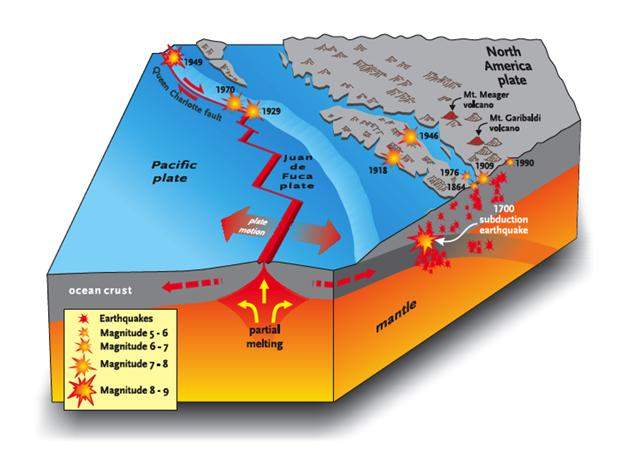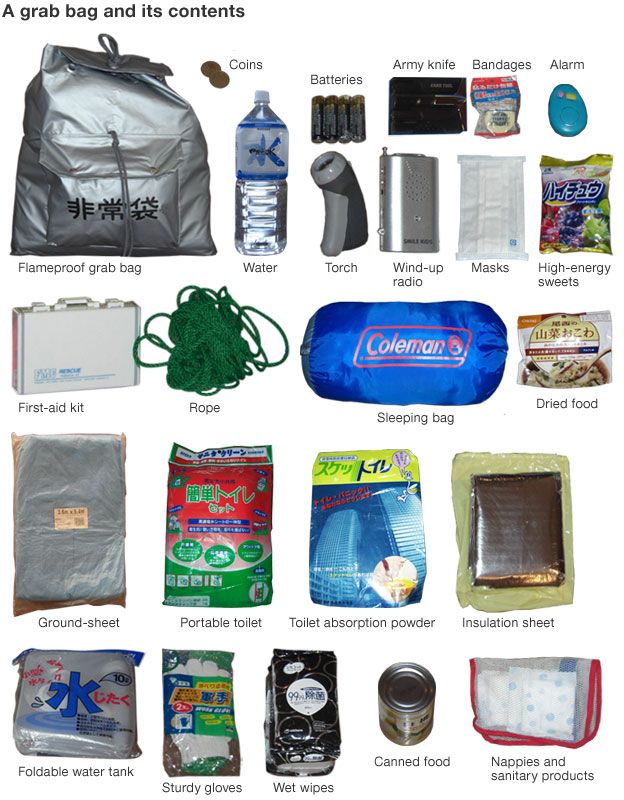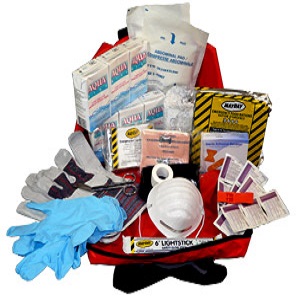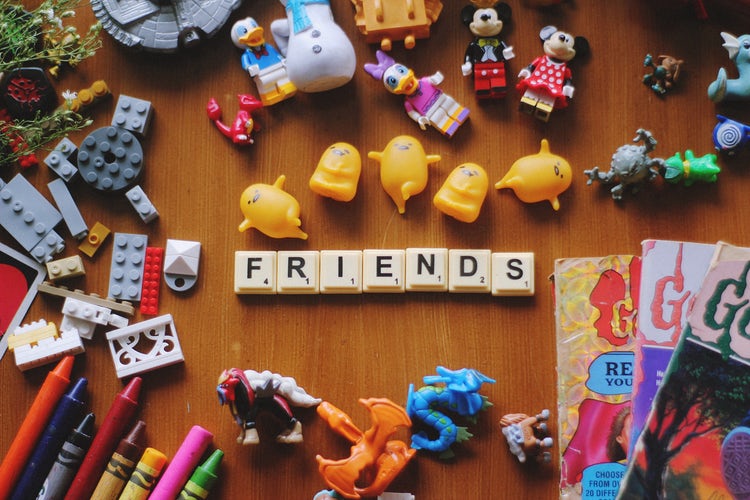What you need in your “Go-Bag”—and why you need one.
Living in Victoria, I never had a “go-bag” or earthquake kit. I didn’t want to spend money on something I might never use.
As a student, each dollar is precious and I used to see spending $50 on an earthquake kit unreasonable. However, I’ve recently moved to Japan for an internship through UVic’s Centre for Asia-Pacific Initiatives, and while living here, I’ve already experienced two earthquakes and two typhoons (with one more currently on schedule to hit this weekend), during which I received an emergency evacuation alert for parts of my city ward, and found myself vastly unprepared.
As many will know, Japan experiences many natural hazards. As such, they take disaster risk reduction (DRR) very seriously. One of the focuses of the organization I work for here, CITYNET Yokohama Project Office (CYO), is DRR. CYO conducts the role of connecting cities throughout Asia to share knowledge and resources, and they focus heavily on DRR. One of their focuses is their annual Disaster Cluster Seminar, which happened early September and was one of my key tasks to take on when I first arrived.
During this seminar, participants from over 30 cities and organizations across Asia came to Yokohama to learn and share knowledge on DRR. As such, I learned so much about how I, as an individual, should be preparing for disasters to increase my chance of survival, both here in Japan and at home in BC.
So, why should you be prepared in Victoria?
Many of us know that Victoria and most of Vancouver Island lie in an earthquake zone. Vancouver Island sits along the Cascadia Subduction Zone, where the Pacific Plate and the Juan de Fuca Plate meet and slide underneath, or subduct, the North American Plate.

The tectonic plates of the Pacific Northwest, showcasing historic seismic events (via the Vancouver Sun: https://www.bbc.com/news/world-asia-pacific-12759840).
For those who have never taken an Earth and Ocean Sciences or Geography course and are unfamiliar with earthquake terminology, essentially, this means Vancouver Island should frequently be experiencing earthquakes. However, as most of you will attest to, Victoria doesn’t really get many earthquakes, maybe about one tiny, almost unnoticeable one per year.
Because of our lack of frequent earthquakes, Canadian seismologists are expecting “The Big One,” a large, devastating earthquake, to hit BC sometime in the near (or not-so-near) future.
Last year, there was an earthquake off the coast of Alaska in January, prompting Tofino and Ucluelet to evacuate due to a tsunami warning. Having an emergency kit ensures you’re at least a little bit prepared for when something unexpected happens—whether it’s a tsunami evacuation warning or a house fire.
Also, a bit of a side note—in Victoria, it’s really important to stockpile water in case of an earthquake. After a field trip to the Sooke Reservoir for a class last year, I learned that if there was a major earthquake, the Greater Victoria Drinking Water System would be at risk of collapse.
Earthquake damage to the reservoir would mean thousands of homes may not get tap water or may get really dirty water, meaning if you haven’t stockpiled your water, you’re drinking out of the toilet bowl until that runs out (yikes!). So, if an earthquake occurs, fill everything up with water as soon as possible—buckets, bathtubs, sinks, etc. This is a tip I learned from a colleague in Japan, as here, if the electricity goes out, so does all your water.

The spillway of the Sooke Lake Reservoir, pictured here in a webcam photo from January 2019 (via CRD https://www.crd.bc.ca/about/data/sooke-lake-reservoir/2018-sooke-lake-reservoir-photos).
What you should have in your Go-Bag
So, to be prepared for disaster, here’s what you should have in your go-bag or earthquake kit, based on information from my city ward office in Japan and the City of Victoria’s website:
- Photocopies of ID: passport, drivers license, health card, and any other important documentation.
- USB with copies of important documents.
- Cash: if you’re like me, and only ever use your credit card, you may be unlikely to have any cash on you. Keep a bit (maybe around $100) in your go-bag so you can still purchase goods if the pin machines are down.
- House keys: keep a copy of your house keys in your go-bag, or if you rent (which you probably do) and can’t make a copy, make sure to always keep your keys in the same spot within easy reach.
- Water bottles: while everyone hates plastic water bottles, you’ll need to have sufficient water in your emergency kit to keep you hydrated. About 72-hours worth, or 4 litres, for an emergency kit, or about 1-2 litres for your go-bag.
- Electrolytes: keep something like Gatorade powder in your kit, as electrolytes are incredibly important to keeping you hydrated.
- Food: in your earthquake kit, stockpile non-perishable food for at least 72 hours; in your go-bag, keep lots of nutrition bars and protein bars for on-the-go.
- Toiletries: tooth paste, tooth brush, soap, and any extra ones you can’t live without (tampons, dare I say?).
- Clothing: keep a change of clothes, including a sweater or light jacket, toque and gloves, multiple pairs of socks, and a pair of running shoes. If you have to evacuate at 4 AM, you don’t want to be out in the street in your pyjamas for too long.
- Shock/foil blanket: in a pinch, these work great for keeping you warm, and you can pick one up at MEC or Canadian Tire for cheap.
- Umbrella: you never know when it could rain!
- Flashlight and batteries.
- Mobile radio: if there’s a lot of damage, cell signals may be down, so pick up a small radio where you can tune in to listen to disaster updates.
- Mobile phone charger: keep a charged portable charger as well as an extra plug-in charger in your go-bag, just in case.
- Small first aid kit.
- Any prescription or other medicines.
- Duct tape.
- Rope or twine.
- Scissors or knife/Swiss army knife.
- Whistle.
The above is just a small suggested list. Depending on how prepared you want to be, you could also keep a range of tools or other items. The City of Victoria has incredibly extensive and handy information on what you should have in your emergency kits (yes, plural!) on their website.
It’s also important to personalize your kits, including any items you know you’ll need to survive if disaster strikes, or even with just any valuable items you don’t want to lose. Keep everything in a backpack or other bag you can easily carry, in a safe yet easily-reachable place.
To make it all easy for you, the UVic Bookstore sells earthquake kits for about $40, with enough resources for three days inside.
UVic’s Emergency Planning site has information on campus safety. Be sure to download the new UVic Safety app and register for UVic Alerts.
In addition, don’t forget to sign up for Vic-Alert to get emergency alerts from the City of Victoria about earthquakes, tsunamis, power outages, and the like.
Make sure you share your emergency plan with friends and family; tell them where you’d go if evacuated, how to get in contact via radio or other means, and make sure your roommates and family members are prepared too.
One final thing I want to mention—we are incredibly lucky in regard to DRR in Victoria, and BC in general. Our infrastructure is well-built, we don’t experience devastating disasters frequently, we have reliable emergency services, and if an earthquake was to occur, it likely wouldn’t flatten entire cities and kill thousands. We have the resources to prepare ourselves compared to many other parts of the world, and it’s a privilege not to worry about whether or not the next heavy rain will wash away our homes or whether or not the firetruck will arrive when I need it.
Spending $100 on an emergency kit is a small sacrifice to make in keeping yourself safe and prepared if a disaster were to occur. And hopefully, you’ll never have to use it.







Oct. 17, 2019
Well done, Meghan,
many thanks!
Monika
Thank you, Monika! 🙂